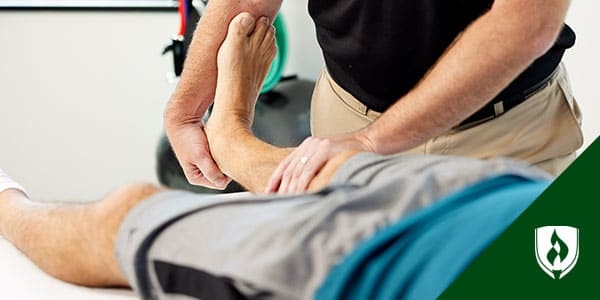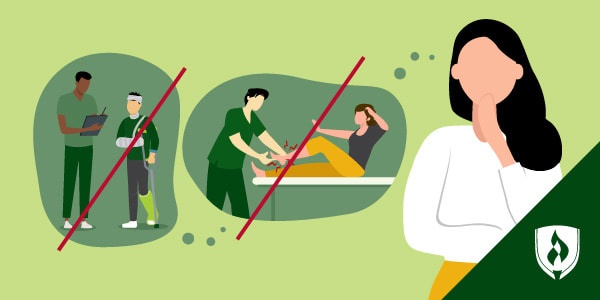Occupational Therapist vs. Physical Therapist: Key Differences
By Noelle Hartt on 05/30/2024

Occupational and physical therapy share many similarities. Both types of care have major impacts on patients’ lives and overall wellbeing. Still, there are several distinct differences between these two healthcare fields.1
So, if you’ve ever wanted to know—What’s the difference between physical therapy and occupational therapy? What treatments does each type of therapy use? And what types of conditions does each career treat? …You’re not the only person wondering.
In this article, we’re breaking down all the facts! Read on for a clearer picture of these two essential practices.
Occupational therapy vs. physical therapy: the basics
Both physical therapy and occupational therapy can help people reduce pain and strengthen their physical skills. Like doctors, nurses and pharmacists, physical and occupational therapists are key players on a healthcare team. Both educate people on their conditions and recommend treatments accordingly.
The main difference between these healthcare professionals lies in the specific focus of each.
Physical therapists primarily focus on helping patients manage pain and improve movement. “They are often an important part of preventive care, rehabilitation, and treatment for patients with chronic conditions, illnesses, or injuries,” according to the Bureau of Labor Statistics (BLS).2
Conversely, occupational therapy focuses on improving patients’ abilities to perform daily living tasks. “Occupational therapists work with people who have permanent disabilities,” explains the BLS.3
These professionals help people perform daily tasks, or “occupations,” in a safe and healthy way. An occupational therapist may show people how to use adaptive equipment—like wheelchairs, for instance—or how to perform exercises and other physical activities that comprise a treatment plan.
Still have some lingering questions about the differences between occupational therapy vs. physical therapy? Let’s take a deeper dive into each!
What is occupational therapy?
An occupational therapist will help individuals work on the fine motor skills needed for daily tasks, like getting dressed and eating. Patients in occupational therapy® (OT) have usually suffered an injury or have a chronic condition that affects their ability to perform everyday activities.
Since OT focuses heavily on quality of life, occupational therapists work with patients to help them navigate their daily routines safely, independently and with confidence. Some OTs help people cope with substance abuse problems.
An occupational therapist may also assist with other mental health challenges, such as intellectual or developmental delays. In these cases, the OT can assist with skills such as time management, using public transportation or completing chores.
The role of occupational therapists
These professionals help patients work towards unique goals. To do this, OTs take a holistic approach, instead of just focusing on physical symptoms. Often, they’ll even travel to a patient’s school, home or work to help create adaptive solutions for these specific environments. Additionally, many OTs work in hospitals, outpatient clinics, schools and long-term care facilities.3
OTs usually need a master’s degree in occupational therapy. After graduating, prospective occupational therapists are required to pass the National Board for Certification in Occupational Therapy (NBCOT®) exam. They must also obtain licensure, however, requirements to do so vary by state.3
And good news! The future looks bright for occupational therapists. The BLS writes that employment is projected to grow 12 percent between 2022 and 2032—faster than average for all occupations.3
The role of occupational therapy assistants
Licensed occupational therapy assistants (OTAs) work alongside OTs in directly providing therapy to patients. This can mean helping patients practice stretches and exercises, leading children in developmental activities and teaching patients how to use special equipment. OTAs keep track of their patients’ progress and report changes to the occupational therapists they work under.
An OTA must earn an occupational therapy degree from an accredited OTA Associate’s program and gain licensure to practice in most states. Other common requirements for occupational therapy assistants include certifications in cardiopulmonary resuscitation (CPR) and basic life support (BLS).
What is physical therapy?
Physical therapy is for patients who have sustained injuries or are dealing with chronic conditions that cause them pain or limit their daily movement. Physical therapy has been shown to help some patients avoid surgery and prevent long-term reliance on medications.
A huge variety of patients can benefit from physical therapy including current or former acute care patients recovering from fractures, surgeries, amputations or transplants. Patients with chronic conditions may also see a physical therapist (PT) for an extended period of time.
Physical therapy treatments can vary quite a bit, but these are some of the most common:
- Manual therapy: includes massage, mobilization, and strengthening exercises
- Exercise: addresses muscular imbalances
- Hot and cold therapy: cold lessens inflammation while heat can reduce tightness
- Ultrasound: promotes circulation and generates heat in connective tissues
- Traction: alleviates pressure on the spine to decompress it
- Laser therapy: generates wavelengths to stimulate healing
- Electrical stimulation: contracts dormant muscles to restore function
The “right” treatment always depends on a patient’s diagnosis and condition. So, what’s it like to work in physical therapy?
The role of physical therapists
Physical therapists are movement experts who excel a finding the source of pain and creating treatment plans that will help patients reach their goals. These professionals have extensive training and practice in diagnosing and administering treatment.
A physical therapist must have a Doctor of Physical Therapy (DPT) degree, and all states require licensure. Some states may have additional requirements which might include passing a law exam or completing a criminal background check.4
Physical therapists may work in a variety of healthcare settings—hospitals, emergency rooms, private practices, outpatient clinics, patients’ homes, schools, sports and fitness centers, work settings and nursing homes. Most PTs work regular daytime business hours, though some might work evening and weekend hours to accommodate patient schedules.
The role of physical therapist assistants
A physical therapist assistant (PTA) helps deliver care to patients under the supervision of a licensed physical therapist. In a given day, PTAs might teach someone how to properly use crutches or a walker, demonstrate strength or mobility exercises, provide massage therapy, measure patients’ progress, or use tools like ultrasound or electrical stimulation to treat patients.
Physical therapist assistants must complete a Physical Therapist Assistant Associate’s degree program. All states also require PTAs to be licensed or certified. Some states may require certain examinations, like the national physical therapy examination (NPTE®). And some states may also mandate criminal background checks and/or passing exams on laws pertaining to PTA practices.4
Becoming a physical therapy assistant may be a great option for those wanting to enter the world of PT and provide therapy without having to earn an advanced degree.
Helping improve patients' everyday lives
OT and PT are both instrumental forms of rehabilitative care. Through each, patients work on physical rehabilitation and can regain pain-free movement or the ability to perform basic daily activities. Whether it's with gross motor skills like walking after a car accident—or small motor skill movements that enable a patient to button their own shirt in the morning, these healthcare roles help patients achieve more in everyday life.
Rasmussen University does not offer any programs that will lead to the career outcomes of Occupational Therapist and Physical Therapist.
To learn more about physical therapy and how it can better a patient’s life, check out our article, “Does Physical Therapy Work? 7 Success Stores That Will Make You a Believer."
EDITOR'S NOTE: This article was originally published in 2017. It has since been updated to include information relevant to 2024.
National Board for Certification in Occupational Therapy® is a registered trademark of NATIONAL BOARD FOR CERTIFICATION IN OCCUPATIONAL THERAPY, INC
NBCOT® is a registered trademark of National Board for Certification in Occupational Therapy, Inc.
NPTE® is a registered trademark of Federation of State Boards of Physical Therapy
1Rasmussen University does not offer any programs that will lead to the career outcomes of Occupational Therapist and Physical Therapist.
2Bureau of Labor Statistics, U.S. Department of Labor, Occupational Outlook Handbook, Physical Therapists, (accessed May 2024), Physical Therapists : Occupational Outlook Handbook: : U.S. Bureau of Labor Statistics (bls.gov)
3Bureau of Labor Statistics, U.S. Department of Labor, Occupational Outlook Handbook, Occupational Therapists, (accessed May 2024), Occupational Therapists : Occupational Outlook Handbook: : U.S. Bureau of Labor Statistics (bls.gov)
4Bureau of Labor Statistics, U.S. Department of Labor, Occupational Outlook Handbook, Physical Therapist Assistants and Aides, (accessed May 2024), Physical Therapist Assistants and Aides : Occupational Outlook Handbook : U.S. Bureau of Labor Statistics (bls.gov)




